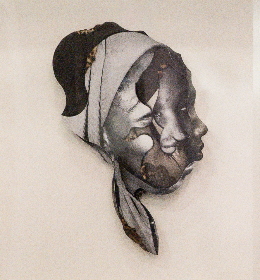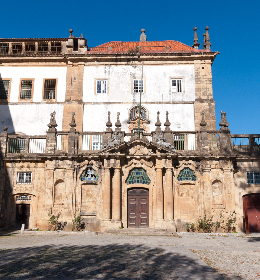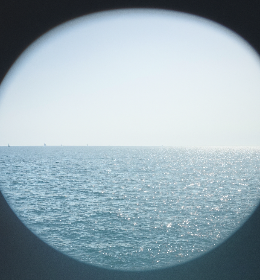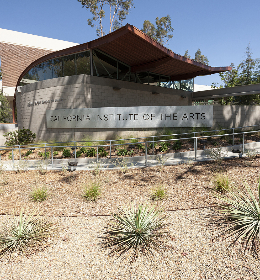Nothing is perfect
Nothing is complete
Nothing lasts
This is the guiding principle - the path that guided the curator Elena Korzhenevich for her first exhibition “IM-PERFECTION” which will be available until 28 July at the galerie burster in Berlin.
It's from the work of the "duo" Mwangi Hutter that the idea for this exhibition was born. Identity, a topic held firmly in the hearts of Mwangi Hutter, is presented to the visitor from the beginning through the seriesViewing a point. The series of photographs challenges the notion of identity, provoking a "deeper reflection on who we are and how our identities are formed".

Mwangi Hutter Viewing a Point 2016 6 c-prints 43 x 33 cm
The visitor is then faced with the work of Amira Parree, a relic of performance and an installation which questions what is left when we disappear and a video by MASBEDO "the desperate attempt and the suffering of a physical being to rise and transcend into a higher metaphysical dimension, where she can join the Light, the Infinite, the Spirit."
Abstract works by Vincent Witomski continue this act of constant questioning and evoke the constant "struggle to find one's identity and reconcile all the inner voices".
Lerato Shadi's performance questions the definition and presence of the body, "Is it the external gaze that defines our body? Can the absence of the body become a statement stronger than its presence?"
A consistency complemented by a selection of works from the collection of the Moleskine Foundation - of which Elena Korzhenevich is co-founder and Director of Communication.

Vincent Witomski Untitled 2018 oil on paper each 55 x 35 cm courtesy Vincent Witomski & galerie burster
Happening met with the curator to further discuss the exhibition and its message:
Can we consider this exhibition as an ode to difference in a political and social way?
I think it’s an ode to an individual in the first place. And of course every individual is unique and different, so yes, in a sense it’s also a celebration of diversity. I conceived the exhibition on a very human level, the intimate implications were the most interesting to me. But then of course the society is made up of human beings, so all the works and messages can also be applied on a social and political level. Embracing the fact that we are not perfect or complete is the first step towards embracing the diversity, the otherness, be it in your personal life or on a level of societies, governments, ethnicities, religions, etc. I would like to think that the selected works are polysemic and can offer the readings on multiple levels.
Perfection is subjective, linked to a norm; is the idea of this exhibition is to highlight the useless and impossible quest for perfection? Especially in countries where, for many reasons, the Occidental way of life, style, consumption, becomes, unfortunately an unrealistic goal?
As you have pointed out perfection is subjective, so the quest for perfection is utopian in the first place. In this exhibition I suggest that perfection is the end, hence it’s death, there is no possibility of evolution in perfection, it’s a closed circle, a stagnant state and honestly it does not interest me. I think much more beauty, variety, spontaneity and inspiration can be found in imperfections, it’s a profoundly human characteristic. Otherwise we can all just be perfectly manufactured machines. In the West we are obsessed with perfection, our aesthetic canons often celebrate symmetry, order, stability. I find asymmetry, improvisation, unpredictability much more exciting and creative. I think the Orient and the South of the world are great sources of inspiration from this point of view.

Mwangi Hutter, Union dance series, (2018) acrylic on canvas.
The message of this exhibition seems very consistent, that is to say, the works address a clear set of thematics, even if they are abstract or conceptual pieces. Does the public now seek these kinds of clear ways of accessing an exhibition?
When I started conceiving this exhibition I wrote a story and a poem, inspired by the works of Mwangi Hutter, which then guided the choice of the selected artists and works. To me there is a very clear conversation that is happening in each room and the works are put in dialogue around 3 specific concepts: nothing is perfect, nothing is complete and nothing lasts. I am happy the message comes through in a coherent manner, that means that my story resonates. But to be honest, I was not thinking about the public and its tastes and ways of accessing an exhibition while I was working. I was interested in telling this story with the works of the artist and then it’s up to the audience to relate to it or not. With the themes being quite universal, I think a wide variety of audiences can identify with it. After all, we are all perfectly imperfect..

MASBEDO, Until the end (2001)
Could you quickly present the Moleskine Foundation collection? What are the criteria of selection for these artworks?
We are a non-profit organization that believes that Creativity and Quality Education are key to producing a positive change in the society. We create unconventional educational tools for youth in the communities affected by cultural and social deprivation. In more than 10 years of activity we have built a collection of unique pieces of work created by different authors and thinkers on Moleskine notebooks and donated to the Foundation to help support its activities. Today we have more than 1000 pieces that come both from the established authors (Pascale Marthine Tayou, Spike Jones, Sigur Ros, Antonio Marras, Nicolas Hlobo, etc.) and from the participants to our educational format AtWork, which was born in Africa and conceived together with the curator Simon Njami. AtWork uses the creative process to stimulate critical thinking and wants to inspire a new generation of creative thinkers. Each participant personalises a notebook at the end of the workshop, which they can then donate to Moleskine Foundation Collection. When I was creating the exhibition it came natural to me to include the works of the young creative talents who participated to AtWork workshops in Africa and created their artworks around the theme of identity and existential quests. I selected 3 works from Kampala and Douala workshops, which spoke to the topics of IM-PERFECTION. The other 2 notebooks were donated to the Collection by the participating artists Mwangi Hutter and Amira Parree. Last, but not least, I have included the work by the US artist Susan Kleinberg titled “We dance”. I thought it was a perfect addition to the exhibition, which I conceived as one elegant human dance.
Henri Robert









